Applicable Products
These instructions apply to the following products:
- Barracuda Intronis Backup - MSP
Hyper-V 2016
With this release of Hyper-V 2016, Barracuda MSP extends support of current Hyper-V features (Standard and Rapid Recovery) to the latest Hyper-V 2016 platform released by Microsoft. Microsoft's RCT technology is used to determine the changed blocks in a virtual disk for a VM running on a Windows Server 2016 system.
Because RCT works only for VMs using the new configuration format introduced with Windows Server 2016 (version 8.0 or later) the backup agent can no longer backup VMs running the older version of the configuration format.
To backup VMs using RCT, the VM’s configuration format must be upgraded to the latest version (8.0). Older VMs still can be added to Hyper-V backups sets, but a warning is displayed that the VMs must be upgraded before being backed up. If the Agent detects a VM using a pre-version 8.0 configuration format running on Windows Server 2016, it does not attempt to back up the VM, instead it logs an error message, and then moves to the next VM in the backup set.
Windows Server 2016 Hyper-V Deployment Considerations
To reduce downtime and allow for an acceptance period, it is recommended that you perform a clean installation of Windows Server 2016 Hyper-V when migrating from previous Hyper-V server versions.
The following table provides the deployment tasks.

For existing Windows Server 2016 Hyper-V deployments, do the following:
- Install/upgrade the latest agent.
- Upgrade the virtual machine configuration file format to v8.0, if necessary.
- Create and run new Hyper-V 2016 backup sets.
If you are running Physical Imaging backups of virtual machines and you want to migrate to Hyper-V 2016, do the following:
- Ensure you have the latest backup set.
- After your new Hyper-V backups have been created, delete the old Physical Imaging subaccounts.
Hyper-V 2016 Backup Agent Software Requirements
The following table provides the requirements for running the Backup Agent software.

Hyper-V Rapid Recovery Backup Overview
Hyper-V Rapid Recovery is a backup set type that backs up full Hyper-V VMs to local storage and allows you to recover important servers quickly.
Hyper-V Rapid Recovery backups protect VMs in a reverse incremental manner. This method allows the most recent state (and the one most likely to be recovered in a disaster) to be recovered in the shortest amount of time. In addition, this method provides a more stable revision chain and requires no scheduled consolidation.
With changed block tracking and an improved recovery point objective, the rapid recovery backup set tracks changes on protected VMs efficiently. This efficiency allows you to schedule VM backups up to every 15 minutes. In case of a disaster, almost no data is lost because the most recent known good state is only a few minutes old.
The backup storage location is where all the backup data (fulls and incrementals) are stored locally.
Local Storage can be on the following:
- Directly attached storage location
- Network share
- Remote share
- Standard disk (512)
- 4K disk
- Sparse file
- When backing up a VHD disk on a 4K disk, the backup data is converted to a VHDX format.
Temporary space of 1 GB is recommended for Hyper-V backups.
Note: The agent must be installed on the Hyper-V host.
Creating Hyper-V Rapid Recovery Backup Sets
To create a Hyper-V Rapid Recovery backup set, perform the following steps.
- Navigate to the Computer page.
The Computer page is displayed.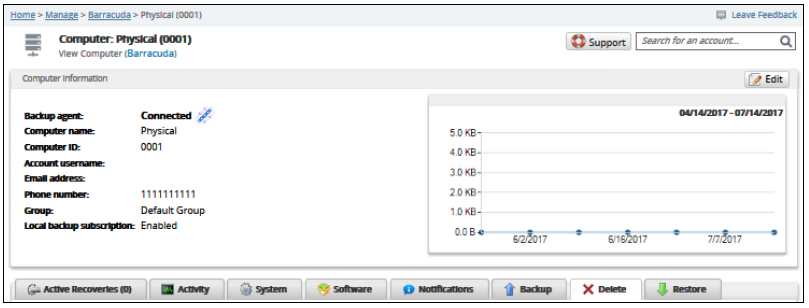
- Click the Backup tab.
The Backup Selections page is displayed.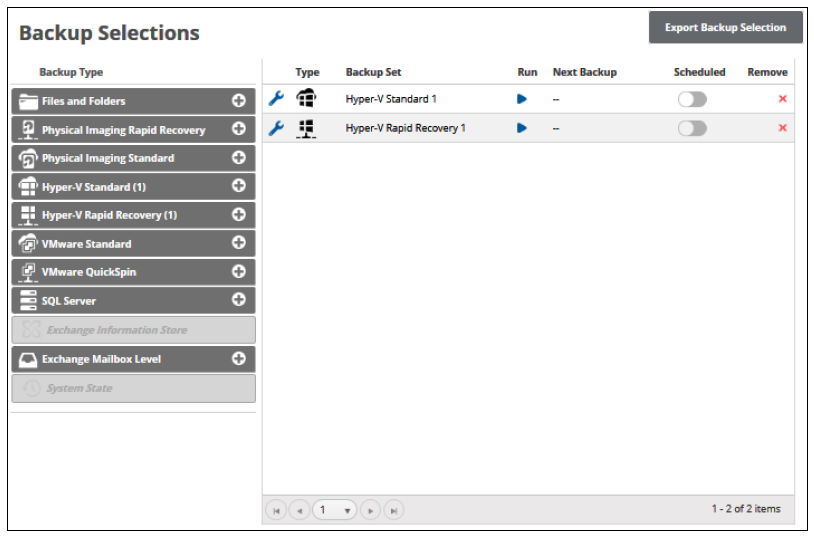
- In the Backup Type pane, click Hyper-V Rapid Recovery.
The Select page is displayed.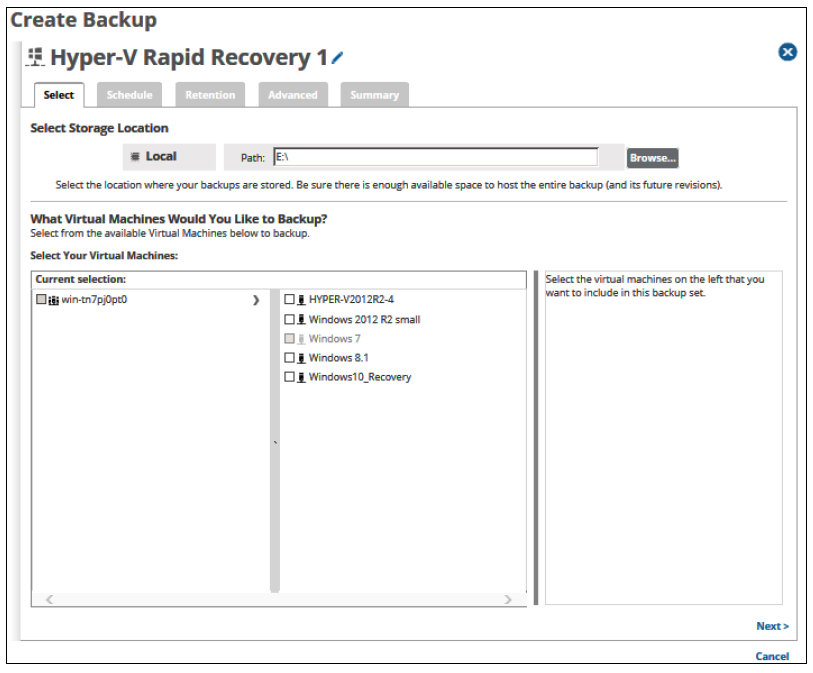
- Click the Backup Name to provide a new name for your backup set or accept the default.
- At the Select Storage Location Path field, type a path, or click the Browse button to select the storage location of your backup.
Important! Ensure there is enough space available to host the entire backup and its future revisions.
Note: Changed locations of the destination hosts of the recovery VMs, are not changed until the next backup set is run. - In the Current selection pane, select the virtual machines you would like to back up.
Notes:- Any VMs that already are included in other backup sets are grayed out.
- A warning icon is displayed for VMs that have not been upgraded.
- Multiple VMs can be included in the same backup set.
 at the right of the VM displays more revisions of the VM.
at the right of the VM displays more revisions of the VM.
Your selections are displayed in the far-right pane. Click the remove icon to remove any selections or clear the item check box.
to remove any selections or clear the item check box.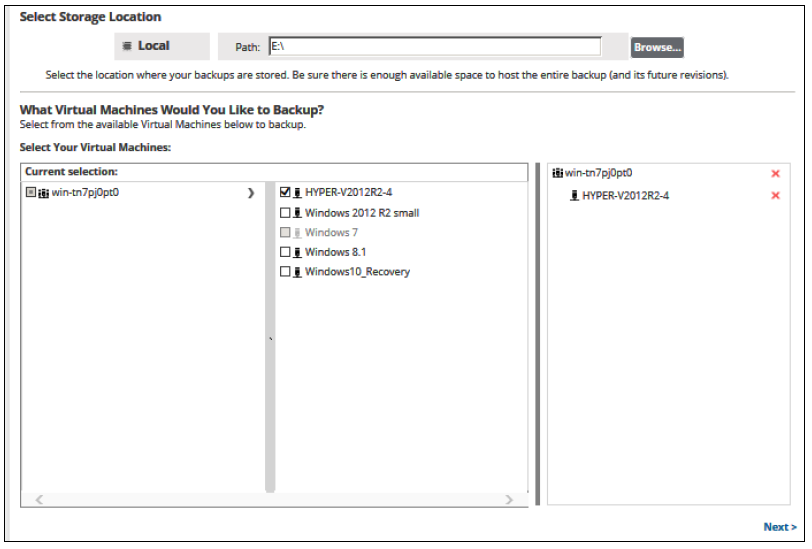
- At the Name field, type a unique name for the backup set.
- After making your selections, click Next.
The Schedule page is displayed.
- Accept or edit the default schedule.
Notes:- The default schedule is every hour.
- Multiple weekly schedules are permitted (if they do not overlap).
- By the minute, hourly or daily recurrences cannot be mixed with weekly recurrences.
- There can only be one by the minute, hourly or daily schedule configured.
- The Allow to Finish check box is always selected and grayed-out.
 to delete schedule.
to delete schedule. - After setting your schedule, click Next.
The Retention page is displayed.
Notes:- You can retain up to 99 revisions per virtual machine. With the default schedule of backing up every 1 hour and keeping 96 versions, up to 4 days of recoverable versions are retained at the storage location.
- The backup set preserves the current state of the virtual machines only. User-generated snapshots are not saved.
- Specify how many recoverable versions of backups at the storage location you would like to retain, and then click Next.
The Advanced page is displayed.
Requirement: You must specify a temporary folder located on a disk with sufficient space. Temporary space of 1 GB is recommended for Hyper-V backups. - At the Temporary Folder field, accept the default, type a new path, or click the Browse button to locate the temporary folder that is used during backing up.
- At the Backup Mode section, optionally select the Allow Crash-Consistent Backups check box.
CAUTION! Crash-consistent backups do not preserve the integrity of data for open files of transactional applications on the VM guest OS and may result in data loss.
Notes:- When crash-consistent backups are enabled, the virtual machine may become unavailable during the snapshot process.
- The software attempts to make an application-consistent backup. If unable, a crash-consistent backup is created

- Click Next.
The Summary page is displayed.
- After reviewing your selections, click the Create Backup Set button.
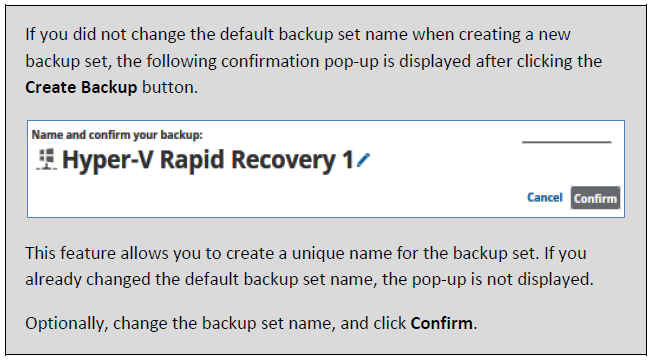
Your scheduled backup is displayed on the Backup Selections page.
